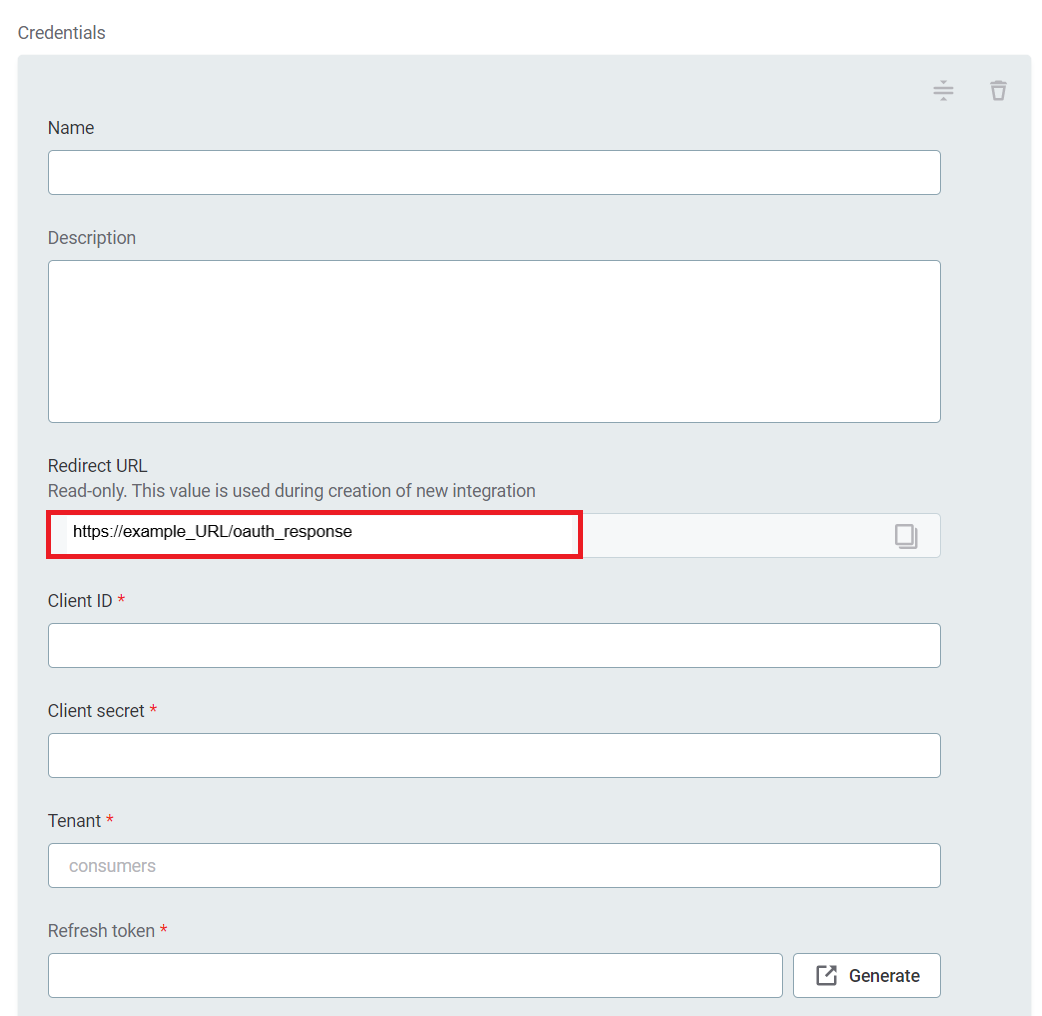Microsoft OneDrive Storage Connection
To connect to Microsoft OneDrive Storage, you must register ONE in the Microsoft Azure Portal as a web application and create a client secret. For more information about how to do this, refer to the official Microsoft documentation, article Register an Application.
| You can follow this guide to connect to Microsoft SharePoint as well. |
| Currently, you can only use a Microsoft OneDrive Storage connection to work with CSV and Microsoft Excel files. |
Prerequisites
To set up the connection in Microsoft Azure Portal, you need to provide the redirect URL for ONE. The value you need to use can be found in the Redirect URL field when configuring the connection in ONE.

Create a source
To connect to Microsoft OneDrive:
-
Navigate to Knowledge Catalog > Sources.
-
Select Create.
-
Provide the following:
-
Name: The source name.
-
Description: A description of the source.
-
Deployment (Optional): Choose the deployment type.
You can add new values if needed. See Lists of Values. -
Stewardship: The source owner and roles. For more information, see Stewardship.
-
| Alternatively, add a connection to an existing data source. See Connect to a Source. |
Add a connection
-
Select Add Connection.
-
In Select connection type, choose File system > OneDrive Storage.
-
Provide the following:
-
Name: A meaningful name for your connection. This is used to indicate the location of catalog items.
-
Description (Optional): A short description of the connection.
-
Drive ID (Optional): If you have multiple drives and you want to limit the connection to a specific drive, enter the ID of the drive you want to connect to.
-
-
In Additional settings, select Allow data export if you want to export data from this connection and use it outside of ONE.
If you want to export data to this source, you also need to configure write credentials as well. Consider the security and privacy risks of allowing the export of data to other locations.
Add credentials
-
Select Add Credentials.
-
Provide the following:
-
Name (Optional): A name for this set of credentials.
-
Description (Optional): A description for this set of credentials.
-
Client ID: The
Application (client) ID. You can find it on the Overview pane of your registered app in Azure.For more information, see the official Microsoft documentation, Register an application.
-
Client secret: The
client secret.For information about how to add and access the
client secretfor this connection, see the official Microsoft documentation, Add a client secret. -
Tenant: Enter the tenant type or the unique identifier of the AAD instance of your Azure subscription. The default tenant type is
consumers.Supported tenant types-
common: Users with both a personal and a work or school account from Azure can sign in to the application.
-
organizations: Only users with a work or school Azure AD account can sign in to the application.
-
consumers: Only users with a personal Microsoft account can sign in to the application.
-
<Specific Azure AD tenant: GUID or domain name must be provided>: Only users from a specific Azure AD tenant can sign in to the application.
Either the domain name or the GUID tenant identifier must be specified. This can be useful if your account belongs to multiple organizations (multiple tenants) and you would like to limit access to a specific tenant.
-
-
-
Copy the Redirect URL value and provide it in Microsoft Azure Portal, as explained in Prerequisites.
-
In Refresh token, select Generate to create a new token.
This opens a Microsoft login screen in your browser. Log in to your Microsoft Account and confirm access. Once you do this, the expiration date of the refresh token is updated in Refresh token valid till. This field is provided for informational purposes only. If you generate a new refresh token, a new expiration date is updated accordingly.
-
Set the credentials to be used as default (Set as default).
One set of credentials must be set as default for each connection. Otherwise, monitoring and DQ evaluation fail, and previewing data in the catalog is not possible.
Add write credentials
Write credentials are required for data export.
To configure these, in Write credentials, select Add Credentials and follow the corresponding step depending on the chosen authentication method (see Add credentials).
| Make sure to set one set of write credentials as default. Otherwise, this connection isn’t shown when configuring data export. |
Test the connection
To test and verify whether the data source connection has been correctly configured, select Test Connection.
If the connection is successful, continue with the following step. Otherwise, verify that your configuration is correct and that the data source is running.
Save and publish
Once you have configured your connection, save and publish your changes. If you provided all the required information, the connection is now available for other users in the application.
In case your configuration is missing required fields, you can view a list of detected errors instead. Review your configuration and resolve the issues before continuing.
Next steps
You can now browse and profile assets from your Microsoft OneDrive connection.
In Knowledge Catalog > Sources, find and open the source you just configured. Switch to the Connections tab and select Document. Alternatively, opt for Import or Discover documentation flows.
Or, to import or profile only some assets, select Browse on the Connections tab. Choose the assets you want to analyze and then the appropriate profiling option.
Was this page useful?
